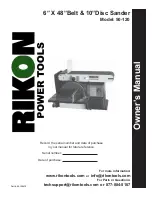
12
Fig. 20
Fig. 22
Fig. 23
1. Apply a light coat of paste wax to the worktable to
make feeding stock easier, and reduce rust.
2. Use compressed air to frequently blow out dust and
debris from sander and motor. (See Fig. 20)
Warning:
To avoid electrocution or fire, any repairs to
electrical systems should be done only by qualified
service technicians. Unit must be reassembled
exactly to factory specifications.
3. If power cord is worn, cut, or damaged in any way,
have it repaired immediately.
Changing the Motor Belt
1. Using a Phillips screwdriver, remove the three pan
head screws located in the cover. (See Fig. 21)
2. Remove the cover.
3. Loosen four M8 hex head screws to allow the
pulleys to shift enough to place belt around them.
Place belt around motor pulley and drive pulley as
shown. (See Fig. 22)
4. Adjust tension of the belt by putting a wrench in
adjusting gap. Push up on wrench to tighten tension
between pulleys.
5. Tighten the four M8 hex head screws carefully.
6. Test belt tension by placing fingers on either side of
the belt and squeeze. There should be about a 1/4
inch give to the belt. (See Fig. 23)
Note: Too much tension on pulley belt may cause
increased noise and over load the motor. Not enough
tension on the pulley belt may cause belt to fail
prematurely.
7. Locate the pulley cover and position inside the
edges of pulley housing.
8. Using a Phillips screwdriver, reinstall and tighten
the three pan head screws.
Maintenance
Warning:
For your safety, remove the plug from
power source outlet before adjusting, maintaining, of
lubricating your belt and disc sander.
Fig. 21
Summary of Contents for 50-120
Page 15: ...15 Parts Explosion...
Page 16: ...16 Notes...




































